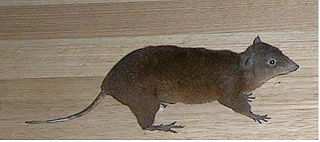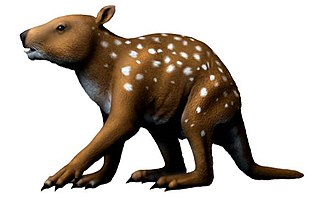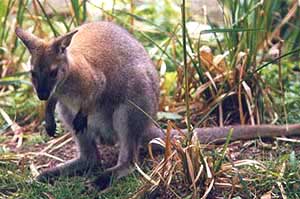
Diprotodontia is the largest extant order of marsupials, with about 155 species, including the kangaroos, wallabies, possums, koala, wombats, and many others. Extinct diprotodonts include the hippopotamus-sized Diprotodon, and Thylacoleo, the so-called "marsupial lion".

The order Peramelemorphia includes the bandicoots and bilbies; it equates approximately to the mainstream of marsupial omnivores. All members of the order are endemic to the twin land masses of Australia-New Guinea and most have the characteristic bandicoot shape: a plump, arch-backed body with a long, delicately tapering snout, very large upright ears, relatively long, thin legs, and a thin tail. Their size varies from about 140 grams up to 4 kilograms, but most species are about one kilogram.

Riversleigh World Heritage Area is Australia's most famous fossil location, recognised for the series of well preserved fossils deposited from the Late Oligocene to more recent geological periods. The fossiliferous limestone system is located near the Gregory River in the north-west of Queensland, an environment that was once a very wet rainforest that became more arid as the Gondwanan land masses separated and the Australian continent moved north. The approximately 100 square kilometres (39 sq mi) area has fossil remains of ancient mammals, birds, and reptiles of the Oligocene and Miocene ages, many of which were discovered and are only known from the Riversleigh area; the species that have occurred there are known as the Riversleigh fauna.

The musky rat-kangaroo is a small marsupial found only in the rainforests of northeastern Australia. First described in the later 19th century, the only other species are known from fossil specimens. They are similar in appearance to potoroos and bettongs, but are not as closely related. Their omnivorous diet is known to include materials such as fruit and fungi, as well as small animals such as insects and other invertebrates. The local Aboriginal name for the species is durrgim yuri.

The Hypsiprymnodontidae are a family of macropods, one of two families containing animals commonly referred to as rat-kangaroos. The single known extant genus and species in this family, the musky rat-kangaroo, Hypsiprymnodon moschatus, occurs in northern Australia. During the Pleistocene, this family included the megafauna genus Propleopus.

Hypsiprymnodon is a genus of macropods. The sole extant species is Hypsiprymnodon moschatus, the musky rat-kangaroo. The genus includes four known fossil species.

Palorchestes is an extinct genus of terrestrial, herbivorous marsupials of the family Palorchestidae. The genus was endemic to Australia, living from the Miocene through to the Pleistocene epochs.

Ekaltadeta is an extinct genus of marsupials related to the modern musky rat-kangaroos. Ekaltadelta was present in what is today the Riversleigh formations in Northern Queensland from the Late Oligocene to the Miocene.

The Macropodiformes, also known as macropods, are one of the three suborders of the large marsupial order Diprotodontia. They may in fact be nested within one of the suborders, Phalangeriformes. Kangaroos, wallabies and allies, bettongs, potoroos and rat kangaroos are all members of this suborder.

Bettongs, species of the genus Bettongia, are potoroine marsupials once common in Australia. They are important ecosystem engineers displaced during the colonisation of the continent, and are vulnerable to threatening factors such as altered fire regimes, land clearing, pastoralism and introduced predatory species such as the fox and cat.

Propleopus is an extinct genus of marsupials. Three species are known: P. chillagoensis from the Plio-Pleistocene, and P. oscillans and P. wellingtonensis from the Pleistocene. In contrast to most other kangaroos, and similar to their small extant relative, the musky rat-kangaroo, they were probably omnivorous.
Ganguroo is a genus of fossil macropods found at Riversleigh in Australia, material dating from the Middle to Late Miocene Epoch. The type species of the genus is Ganguroo bilamina, published in 1997. Two recently described species, Ganguroo bites and Ganguroo robustiter, have also been placed in this genus.
The Macropodidae are an extant family of marsupial with the distinction of the ability to move bipedally on the hind legs, sometimes by jumping, as well as quadrupedally. They are herbivores, but some fossil genera like Ekaltadeta are hypothesised to have been carnivores. The taxonomic affiliations within the family and with other groups of marsupials is still in flux.
Malleodectes is a genus of unusual marsupial, first discovered in 2011 at Riversleigh, Queensland, Australia. It could grow as large as a ferret, and lived in the Miocene, 17 million years ago. The reason for its name, which means "Hammer Biter", is because it has blunt, hammer-like teeth, not known from any other mammal extant or extinct. However, Scott Hocknull from the Queensland Museum has noticed similarities to the modern pink-tongued skink, a reptile specialised for eating snails. This suggests that Malleodectes too was a specialised snail hunter.
Cookeroo is a genus of extinct kangaroos from the Late Oligocene and Early Miocene found in fossil deposits from the Riversleigh World Heritage Area, in Australia. The genus includes two species, C. bulwidarri and C. hortusensis.
Riversleigh fauna is the collective term for any species of animal identified in fossil sites located in the Riversleigh World Heritage Area.
Ekaltadeta jamiemulvaneyi is a species of potoroid marsupial that existed in later periods of Miocene Australia.

Crash bandicoot is an extinct bandicoot, known from fossils located at the Riversleigh World Heritage Area in northeast Australia.
Liyamayi dayi is a mammal species of the Thylacomyidae family known from fossils located at the Riversleigh World Heritage Area in northeast Australia. The discovery of the specimens was identified as deposited around fifteen million years ago, revising the earliest record of this peramelemorphian lineage from those of species that existed around ten million years later.
Karen H. Black, born about 1970, is a palaeontologist at the University of New South Wales. Black is the leading author on research describing new families, genera and species of fossil mammals. She is interested in understanding faunal change and community structure in order to gain new understandings of past, current and future changes in biodiversity which are driven by climate.










